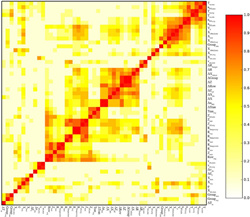Predicting defect behavior in B2 intermetallics by merging ab initio modeling and machine learning (由从头建模和机器学习法共同预测B2金属间化合物缺陷行为)
 Bharat Medasani, Anthony Gamst, Hong Ding, Wei Chen, Kristin A Persson, Mark Asta, Andrew Canning & Maciej Haranczyk
Bharat Medasani, Anthony Gamst, Hong Ding, Wei Chen, Kristin A Persson, Mark Asta, Andrew Canning & Maciej Haranczyk
npj Computational Materials 2, Article number: 1 (2016)
doi:10.1038/s41524-016-0001-z
Published online:09 December 2016
Abstract| Full Text | PDF OPEN
摘要:利用带立方B2晶体结构(等原子化合物AB)系统作为实例,本研究提出了一种结合机器学习和高通量计算来预测二元金属间化合物(A–B)点缺陷行为。就我们所知,这是首次应用机器学习模型来研究点缺陷属性的工作。采用高通量第一性原理密度泛函理论计算了100个 B2型金属间化合物的本征点缺陷能量。该系统化合物可分为两组:(i)本征缺陷为错位,A和B均富含的缺陷,及(ii)以空穴为主的缺陷,是A或B中,或者A和B都有的缺陷。数据采用决策树机制的机器学习技术进行分析,之后还作了全部和缩减的多加性回归树(MART)模型分析。这三个分析方案中,缩减MART (r-MART)模型使用六个描述符(形成能量、电子密度的Wigner–Seitz小室边界最小量和差额量、原子半径差、最大原子数、最大电负性),计算结果显示了最高的匹配度(98 %)和预测精度(75 %)。该模型可以用来预测其他B2化合物的缺陷行为,我们发现,系统中45 %的化合物是以空穴缺陷为特征的,是A或B,或两者都有的缺陷。预测材料中占主导地位的缺陷类型,对金属间化合物的热力学和动力学性能的建模非常重要。本研究结果证实,使用现代工具,结合高通量计算和数据分析,可以实现材料缺陷类型的预测。
Abstract: We present a combination of machine learning and high throughput calculations to predict the points defects behavior in binary intermetallic (A–B) compounds, using as an example systems with the cubic B2 crystal structure (with equiatomic AB stoichiometry). To the best of our knowledge, this work is the first application of machine learning-models for point defect properties. High throughput first principles density functional calculations have been employed to compute intrinsic point defect energies in 100 B2 intermetallic compounds. The systems are classified into two groups: (i) those for which the intrinsic defects are antisites for both A and B rich compositions, and (ii) those for which vacancies are the dominant defect for either or both composition ranges. The data was analyzed by machine learning-techniques using decision tree, and full and reduced multiple additive regression tree (MART) models. Among these three schemes, a reduced MART (r-MART) model using six descriptors (formation energy, minimum and difference of electron densities at the Wigner–Seitz cell boundary, atomic radius difference, maximal atomic number and maximal electronegativity) presents the highest fit (98 %) and predictive (75 %) accuracy. This model is used to predict the defect behavior of other B2 compounds, and it is found that 45 % of the compounds considered feature vacancies as dominant defects for either A or B rich compositions (or both). The ability to predict dominant defect types is important for the modeling of thermodynamic and kinetic properties of intermetallic compounds, and the present results illustrate how this information can be derived using modern tools combining high throughput calculations and data analytics.
Editorial Summary
Machine learning a defect’s effect (机器学习可以有效预测缺陷类型)
美国研究人员开发了一种快速预测材料中占主导地位的平衡原子级缺陷的方法。原子间的组合规则和对称安排,决定了由其构成的结晶材料的诸多属性。因此,缺少一个或出现一个杂质原子可以明显地改变这些属性。被称为密度泛函理论计算的量子物理方法,已被证明是一个预测这些点缺陷影响的强有力的方法。然而,材料的性能都是由点缺陷引起的,这个强大方法的应用若没有强大的计算能力,将难以高通量地筛选成千上万种材料的各种性能。来自劳伦斯伯克利国家实验室的Bharat Medasani及其同事,应用机器学习与密度泛函理论的上百个计算,可使这个筛选过程更快。他们通过检测一族二元金属间化合物合金的性能,证实了这种方法的高效性。
A method for quickly predicting the dominant equilibrium atomic-level defects in a material is developed by researchers in the USA. Crystalline materials derive many of their attributes from the regular and symmetric arrangement of their atoms. Consequently, a missing or an impurity atom can noticeably change these properties. A quantum physics method known as density functional theory calculations has proven to be a powerful method for predicting the influence of these so-called point defects. However, the brute-force application of these methods requires significant computing power, thus hindering its application in high throughput screening of thousands of materials for properties influenced by point defects. Bharat Medasani from the Lawrence Berkeley National Laboratory and co-workers combine machine learning with a few hundred density functional theory calculations to make this process much faster. They demonstrate the power of their approach by examining the properties of a family of binary intermetallic alloys.


 沪公网安备 31010502006565号
沪公网安备 31010502006565号